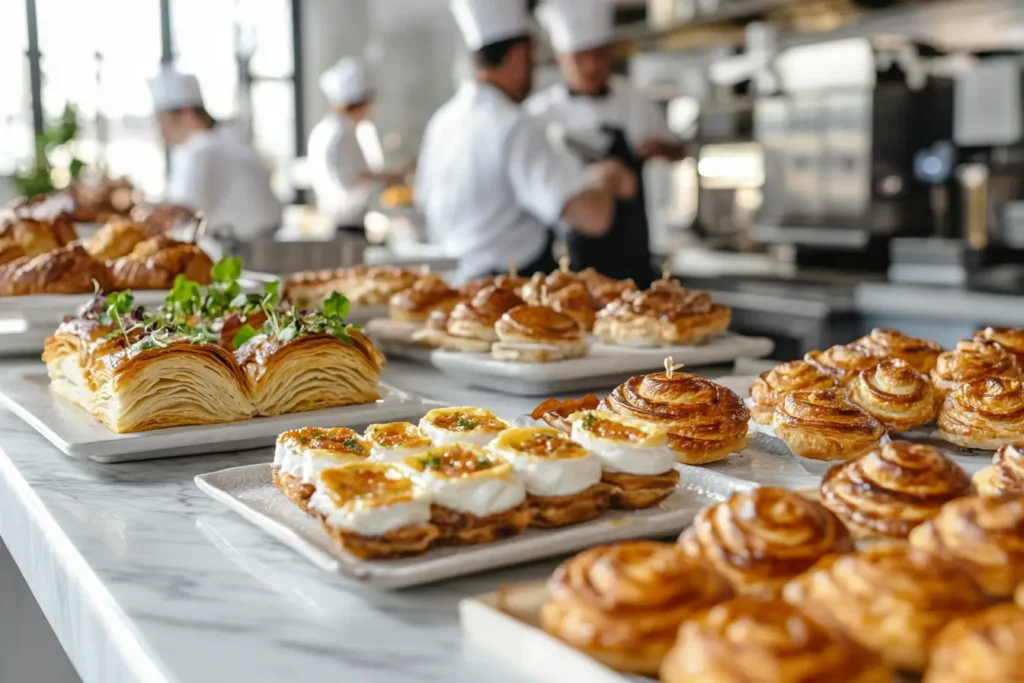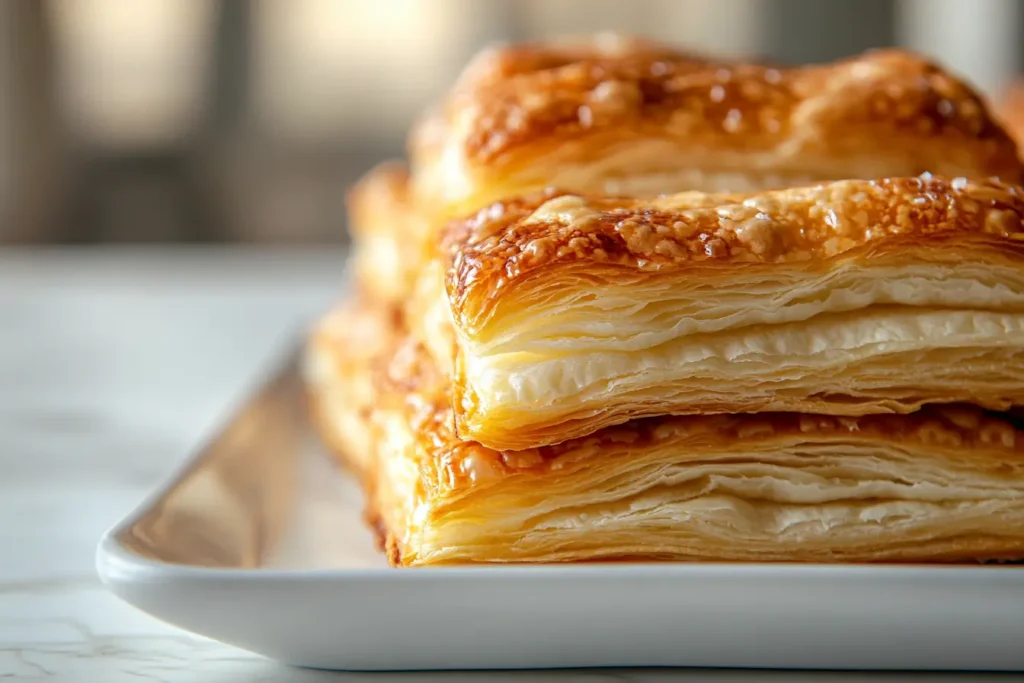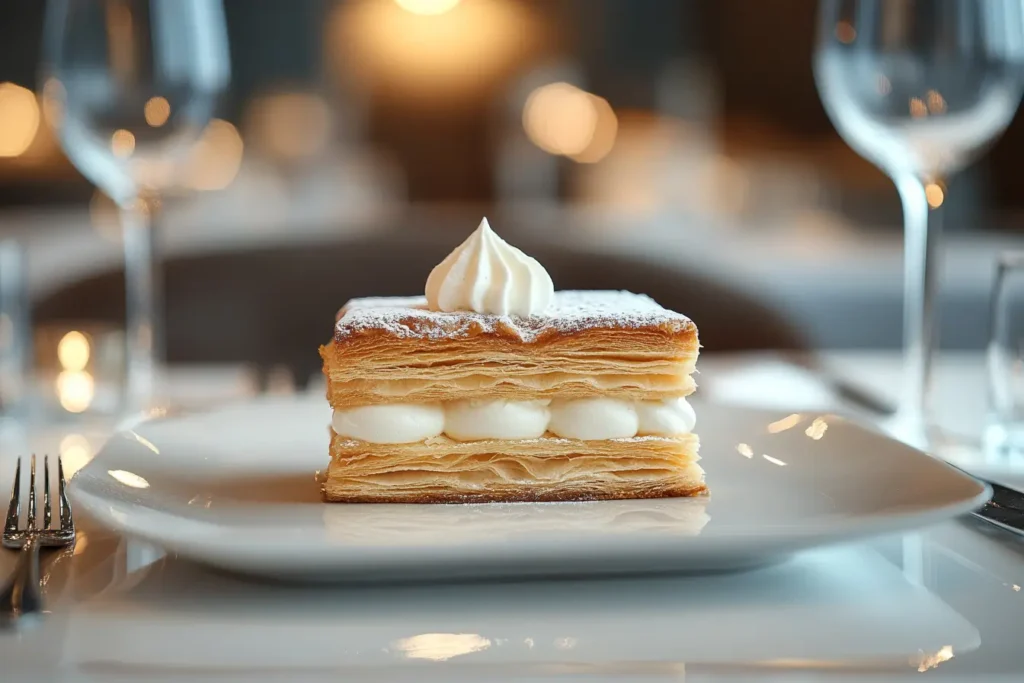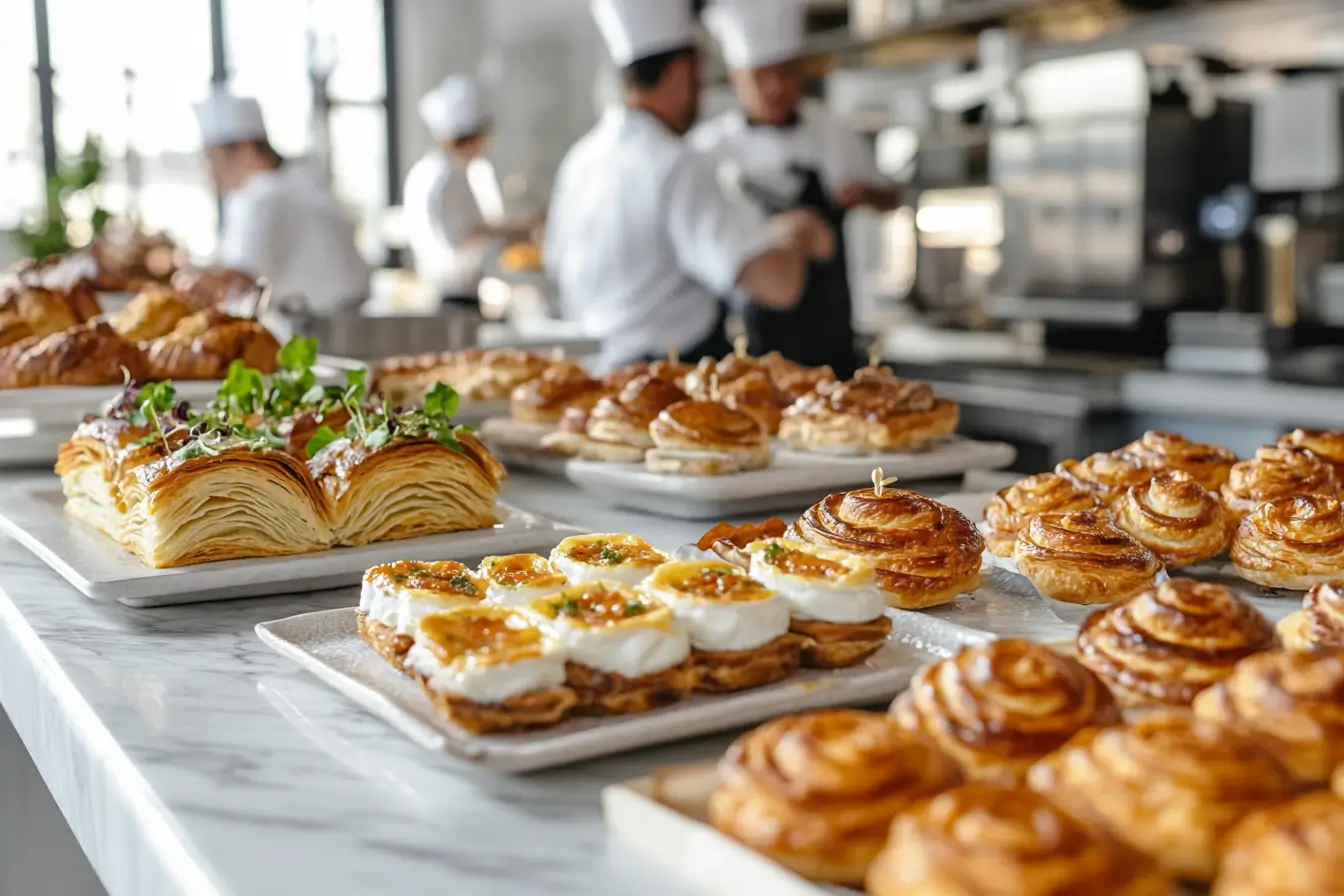
Introduction to Puff Pastry
Types of Puff Pastry are a cornerstone of baking, delivering flaky, buttery perfection in every bite. If you’ve ever marveled at the flaky, buttery goodness of a croissant or a savory puff pastry pie, you’ve tasted the magic of puff pastry. But did you know there are three distinct types of puff pastry? That’s right! Not all puff pastry is created equal. Each type has its unique characteristics, best uses, and quirks. Whether you’re a professional chef or a curious home baker, understanding these differences can elevate your culinary game. Ready to dive into the world of layers and flakes? Let’s go! 🥐✨

What Makes Puff Pastry Unique?
Puff pastry is a marvel of culinary engineering. At its core, it’s built on a simple concept: layering dough and fat to create an airy, flaky texture. When baked, the magic truly happens. The heat causes the moisture in the dough to turn to steam, which then lifts those delicate layers to create a light and crispy texture. In many ways, it’s the pastry equivalent of an accordion – it’s all about the layers! Moreover, the precision in layering is what gives puff pastry its unique charm and versatility.
The Role of Layers in Puff Pastry
Why so many layers? Each fold and turn increases the number of layers exponentially. A classic puff pastry recipe can have hundreds of layers! More layers mean more flakes, and who doesn’t love a good flake? 🧈💕
The Types of Puff Pastry Explained
Mastering Full Puff Pastry: Traditional and Flaky Layers
Let’s start with the OG of puff pastries – full puff pastry. This is the kind you probably think of when you imagine a perfectly golden, flaky pastry. It’s all about precision here.
Key Characteristics of Full Puff Pastry
Full puff pastry is rich, flaky, and buttery. It requires the most work because of its many folds and turns. The result? A dough with layers so thin and even, it’s practically a work of art.
“Full puff pastry is the ultimate expression of patience and skill – and boy, is it worth it!”
Common Uses of Full Puff Pastry
Full puff pastry shines in elegant dishes. Use it for mille-feuille, vol-au-vents, or even those irresistible cheese straws. Whether sweet or savory, this type is all about making a statement.
Why Half Puff Pastry Is a Perfect Middle Ground
Next up is half puff pastry. Think of this as the middle child – still impressive, but a little less fussy.
Key Characteristics of Half Puff Pastry
Half puff pastry has fewer layers, so it’s slightly less flaky but still offers a beautiful texture. It’s quicker to make than full puff, which makes it perfect for bakers short on time.
Common Uses of Half Puff Pastry
You’ll often see this type in simpler recipes like turnovers or rustic galettes. It’s versatile, approachable, and still has plenty of character. 🍎🥧
Quick and Easy: The Charm of Rough Puff Pastry
Now, let’s talk about the rebel of the group – rough puff pastry. It’s quick, easy, and a bit rough around the edges, but it still delivers on flavor and texture.
Key Characteristics of Rough Puff Pastry
Unlike its siblings, rough puff pastry skips the traditional folding process. Instead, you cut butter into the dough, creating a more rustic but equally delicious result.
“Rough puff pastry proves that perfection isn’t always necessary – as long as it tastes amazing!”
Common Uses of Rough Puff Pastry
This type is ideal for casual bakes like sausage rolls or pot pies. It’s perfect for when you want puff pastry without the hassle.
How to Choose the Right Type of Puff Pastry
Not sure which one to use? Don’t worry, we’ve all been there. Here’s how to decide:
Factors to Consider When Selecting Puff Pastry
- Time on Hand: If you’ve got the time and patience, go for full puff pastry. For a quick fix, rough puff is your best friend.
- Recipe Complexity: Fancy desserts? Full puff. Savory pies? Rough puff. Everyday bakes? Half puff works great.
- Texture Preference: Want extra flaky? Stick with full puff. Need something sturdy? Half puff or rough puff will do.
Matching the Type to the Recipe
Think about what you’re making. For example, a delicate mille-feuille calls for full puff pastry. A hearty meat pie? Rough puff gets the job done.
Common Problems with Puff Pastry
Even seasoned bakers run into issues with puff pastry. But don’t worry – we’ve got solutions to keep your layers flawless.
Dough Doesn’t Puff Properly
Ever pulled a flat, sad pastry out of the oven? Yeah, we’ve been there.
Causes and Solutions
- Cause: Butter melted too early.
- Solution: Keep everything cold! Chill your dough and butter before rolling.
- Cause: Overworking the dough.
- Solution: Handle it gently. Think of it as a delicate dance, not a wrestling match.
Tough or Dry Pastry Layers
Nobody likes tough pastry. It’s like biting into cardboard – no thanks. 😅
Causes and Solutions
- Cause: Not enough butter.
- Solution: Be generous with the butter (but not too much, or it’ll leak).
- Cause: Overbaking.
- Solution: Keep an eye on your oven. Puff pastry should be golden, not burnt.
Uneven Puffing or Shrinkage
One side puffing while the other stays flat? That’s a heartbreaker.
Causes and Solutions
- Cause: Uneven rolling.
- Solution: Roll evenly and avoid pressing too hard on the edges.
- Cause: Dough wasn’t rested.
- Solution: Let it chill (literally) before baking.
Tips for Perfect Puff Pastry Every Time
Making puff pastry is like crafting a masterpiece—it requires patience, precision, and a little bit of love. But don’t worry, with these tips, you’ll be a puff pastry pro in no time. Let’s break it down!
Importance of Proper Rolling and Folding
Rolling and folding are the backbone of puff pastry. Each fold creates those magical layers we all adore. But how you handle your dough makes a huge difference.
- Keep It Cool: Always work with cold butter and dough. Warm butter melts and ruins the layers. Think of it like building a sandcastle—if the sand is too wet, it collapses. 🏰
- Even Pressure: Use steady, even pressure when rolling. Uneven pressure can lead to inconsistent layers.
- Rest Between Folds: After each fold, let your dough rest in the fridge. It’s like giving it a power nap—it comes back stronger and ready for more.
The Role of Temperature and Resting
Ever heard the phrase “cool as a cucumber”? That’s exactly how your dough should be. Keeping your pastry cold is key to success. Why? Cold butter creates steam when baked, which lifts the layers.
Pro Tip: “If your kitchen is warm, pop your tools (rolling pin, board) in the fridge before starting. Every little bit helps!” ❄️
Using the Right Fat: Butter vs. Margarine
Ah, the age-old debate: butter or margarine? Spoiler alert—there’s no wrong answer. But each has its perks.
- Butter: For that rich, indulgent flavor, nothing beats butter. It’s the gold standard for puff pastry. Plus, butter’s higher water content creates extra steam for puffing.
- Margarine: A budget-friendly option, margarine is easier to work with because it stays firmer at higher temperatures. While it’s less flavorful, it gets the job done.
Delicious Recipes You Can Make with Pastry
Puff pastry isn’t just versatile—it’s magical. Not only does it work for sweet treats, but it also shines in savory delights. In fact, the possibilities are endless when it comes to creating something special. So, let’s dive in and explore some crowd-pleasers that are bound to impress. Whether you’re a novice baker or a seasoned chef, puff pastry offers something for everyone.
Sweet Treats to Satisfy Your Cravings

Got a sweet tooth? Puff pastry has your back. These classic desserts not only satisfy cravings but also showcase puff pastry’s elegant side.
- Mille-Feuille: Also known as Napoleon, this elegant dessert layers puff pastry with cream and icing. As a result, it becomes a symphony of flavors and textures that’s hard to resist. Moreover, its intricate design makes it perfect for special occasions.
- Palmiers: These heart-shaped pastries are buttery, crispy, and kissed with sugar. In addition, they are perfect for a coffee break or a tea party. ☕💕 What’s more, they’re incredibly simple to make, making them a favorite for both beginner and experienced bakers.
In short, puff pastry desserts are all about combining flavor and finesse.
Savory Snacks and Meals Worth Trying
Not into sweets? No problem! Puff pastry’s savory side is just as exciting. For instance, sausage rolls are a classic choice. Puff pastry wraps around seasoned sausage meat, creating the ultimate snack. Additionally, you can elevate them by adding a sprinkle of sesame seeds for extra flair. Similarly, vol-au-vents offer endless possibilities. These little pastry cases can be filled with anything, such as creamy mushrooms or shrimp cocktail. As a result, they’re the MVP of party appetizers, perfect for impressing your guests.
History and Evolution of Types Puff Pastry
Every great dish has a story, and puff pastry is no exception. In fact, its journey from ancient kitchens to modern bakeries is as layered as the pastry itself. Moreover, this evolution highlights the creativity and skill of bakers throughout history, showing how techniques and flavors have been refined over time. As a result, puff pastry remains a timeless favorite in kitchens around the world.
Origins of Puff Pastry
The roots of puff pastry trace back to ancient times, with early versions appearing in Egypt and Greece. In fact, these early bakers experimented with layering dough and fat, eventually laying the groundwork for the puff pastry we know today. Moreover, their innovative techniques not only inspired modern pastry-making but also paved the way for the flaky, buttery layers we cherish. As a result, puff pastry has become a timeless culinary art.
Modern Adaptations of Types Puff Pastry Techniques
Fast forward to today, and puff pastry has become a global superstar. Modern chefs have developed shortcuts like rough puff, making this once time-intensive process more accessible to home bakers.
Fun Fact: “Did you know that the French term for puff pastry, ‘pâte feuilletée,’ translates to ‘leafed dough’? Makes sense, doesn’t it?” 🌿
FAQs About Types Puff Pastry
1. What is the difference between puff pastry and other pastries?
Puff pastry stands out because of its layers of dough and butter, which expand during baking to create a light, airy texture. Unlike shortcrust or filo pastry, puff pastry relies on the power of steam to lift its layers and achieve that signature flakiness. For a broader look at popular dessert options, check out Common Desserts to see how puff pastry compares to other sweet treats.
2. Can I freeze puff pastry after making it?
Yes! Puff pastry is freezer-friendly. Wrap it tightly in plastic wrap and store it in an airtight container to prevent freezer burn. When you’re ready to use it, thaw it in the fridge overnight. For recipes that use frozen puff pastry in creative ways, explore Puff Pastry Dessert Recipes for some inspiration.
3. Why does my pastry not puff properly?
Several factors can affect puff pastry’s performance:
- Warm butter: If the butter melts before baking, the layers won’t form properly.
- Improper chilling: Puff pastry must stay cold before going into a hot oven.
- Incorrect oven temperature: Always preheat your oven to the correct temperature for optimal puffing.
For additional tips on ensuring perfect pastry dishes, you might enjoy reading about Breakfast Pie Recipes as they often incorporate puff pastry for a delicious breakfast twist.
4. Can I use margarine instead of butter for puff pastry?
Yes, you can use margarine, but keep in mind that butter imparts a richer flavor and better texture. Margarine is a budget-friendly and practical alternative, especially for kitchens in warmer climates. If you’re curious about how puff pastry can enhance a variety of dishes, visit Puff Pastry Dessert Recipes for ideas.
5. What are some easy puff pastry recipes for beginners?
Start with simple recipes like turnovers or cheese straws. These are forgiving for beginners and don’t require a lot of intricate folding or shaping. For more advanced ideas, explore recipes that involve layering flavors, such as mille-feuille, or savory options like sausage rolls. You can also find creative recipes at Puff Pastry Dessert Recipes for inspiration.
Conclusion
Puff pastry is more than just a recipe—it’s a culinary adventure. From the buttery folds of full puff pastry to the quick-and-easy rough puff, mastering these types unlocks a world of possibilities in the kitchen. Whether you’re crafting a delicate mille-feuille or a hearty pot pie, puff pastry adapts to every occasion with flair and flavor.
If you’re just starting, don’t worry about perfection. Baking is a journey, and each roll and fold teaches you something new. And with resources like Breakfast Pie Recipes and Common Desserts, you’ll have endless inspiration to keep experimenting.
“Cooking is an art, but puff pastry is its masterpiece. Take your time, enjoy the process, and let the layers speak for themselves!” 🥐✨

